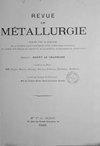Numerical analysis of local heat flux and thin-slab solidification in a CSP funnel-type mold with electromagnetic braking
Revue De Metallurgie-cahiers D Informations Techniques
Pub Date : 2020-01-01
DOI:10.1051/metal/2020044
引用次数: 6
Abstract
In this article, based on the actual monitored temperature data from mold copper plate with a dense thermocouple layout and the measured magnetic flux density values in a CSP thin-slab mold, the local heat flux and thin-slab solidification features in the funnel-type mold with electromagnetic braking are analyzed. The differences of local heat flux, fluid flow and solidified shell growth features between two steel grades of Q235B with carbon content of 0.19%C and DC01 of 0.03%C under varying operation conditions are discussed. The results show the maximum transverse local heat flux is near the meniscus region of over 0.3 m away from the center of the wide face, which corresponds to the upper flow circulation and the large turbulent kinetic energy in a CSP funnel-type mold. The increased slab width and low casting speed can reduce the fluctuation of the transverse local heat flux near the meniscus. There is a decreased transverse local heat flux in the center of the wide face after the solidified shell is pulled through the transition zone from the funnel-curve to the parallel-cure zone. In order to achieve similar metallurgical effects, the braking strength should increase with the increase of casting speed and slab width. Using the strong EMBr field in a lower casting speed might reverse the desired effects. There exist some differences of solidified shell thinning features for different steel grades in the range of the funnel opening region under the measured operating conditions, which may affect the optimization of the casting process in a CSP caster.电磁制动CSP漏斗型结晶器局部热流密度与薄板凝固数值分析
本文根据热电偶布置密集的结晶器铜板的实际温度监测数据和CSP薄板结晶器的磁通密度测量值,分析了电磁制动漏斗型结晶器的局部热流密度和薄板凝固特性。讨论了含碳量为0.19%C的Q235B和含碳量为0.03%C的DC01两种钢种在不同工况下的局部热流密度、流体流动和凝固壳生长特性的差异。结果表明:横向局部热通量最大值出现在距离宽面中心0.3 m以上的半月板区域附近,对应于CSP漏斗型模具的上层流动循环和较大的湍流动能;增大板坯宽度和降低浇注速度可以减小半月板附近横向局部热流密度的波动。当凝固壳被拉过从漏斗曲线到平行固化区的过渡区后,宽面中心的横向局部热流密度减小。为了达到相似的冶金效果,制动强度应随浇注速度和板坯宽度的增加而增加。在较低的铸造速度下使用强EMBr场可能会逆转预期的效果。在实测工况下,不同钢种在漏斗开孔范围内的凝固壳薄化特征存在一定差异,这可能影响CSP连铸机铸造工艺的优化。
本文章由计算机程序翻译,如有差异,请以英文原文为准。
求助全文
约1分钟内获得全文
求助全文
来源期刊
自引率
0.00%
发文量
0
审稿时长
24 months

 求助内容:
求助内容: 应助结果提醒方式:
应助结果提醒方式:


